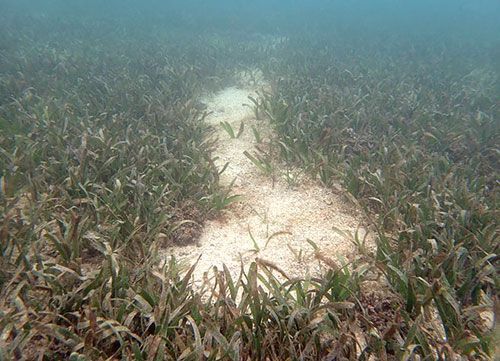Ministry of Environment survey reveals recent dugong feeding trails near Hateruma and Irabu Islands

Marks appearing to be dugong feeding trails seen in the sea near Irabu Island (photograph provided by the Ministry of the Environment)
April 1, 2020 Ryukyu Shimpo
(Tokyo) On March 31, the Ministry of the Environment compiled its results from FY 2019 surveys of the state of habitation of the dugong, which is a Natural Monument of Japan, and revealed that it found new marks thought to be dugong feeding trails near Hateruma Island and Irabu Island. 2019 was also the first year surveyed in which no feeding trails were seen off the coast of Kayo in Nago.
The Ministry of the Environment carried out surveys on Hateruma Island and the surrounding area after receiving information from an interview with a relevant organization in FY 2018 that a dugong had been spotted there.
Marks thought to be dugong feeding trails were found at 64 locations near Irabu Island. There were eight locations where a high density of feeding trails was seen. Interviews with local residents resulted in four reports of observation of a large animal thought to be a dugong.
Marks thought to be feeding trails were seen at three locations near Hateruma Island. Since no new plant growth was seen, it was estimated that a dugong was feeding there very recently. Interviews also revealed that one dugong had been seen.
Meanwhile, the ministry was not able to capture a photograph of a dugong at any location. A survey experimentally conducted near Irabu Island using new technology for detecting dugong DNA in the water did not reveal any DNA detection.
The Ministry of the Environment plans to continue conducting surveys on the basis of expert opinion that there is a high likelihood, based on the presence of feeding trails, that dugongs are present in these areas.
Meanwhile, surveys at three locations near the northern part of Okinawa Island, where surveys have been conducted regularly for some time, did not reveal any feeding trails in the sea near Kayo, where trails were observed each year up until FY 2018. The Okinawa Defense Bureau also did not observe any feeding trails in its recent survey there.
No feeding trails were seen near Kouri or Sumuide either.
The Ministry of the Environment stated that there is a possibility that the dugongs moved to a different feeding location, and also pointed out that feeding trails can sometimes disappear temporarily. It announced that, while knowing that the endeavor will be difficult, it plans to keep investigating signs of dugong activity.
(English translation by T&CT and Sandi Aritza)
Previous Article:JetStar Japan to suspend all flights from Shimojishima Airport to Narita and all connecting flights from April 10 –May 6
Next Article:Man arrested for fraud after buying cigarettes using imitation “money for the afterlife”
[Similar Articles]
- One of only three Okinawa dugong specimens found dead, whereabouts of other two unknown
- Bite marks of dugong found close to Henoko relocation area
- Dugong survey fails to confirm that dugong still inhabit ocean around Okinawa Island
- Two missing dugongs may substantiate OPG claim that Henoko construction harms environment
- Dugong not seen since 2015, possibly due to impact of Oura Bay construction
 Webcam(Kokusai Street)
Webcam(Kokusai Street)


